Original Dixieland Jass Band
The Original Dixieland Jass Band (ODJB) was a Dixieland jazz band that made the first jazz recordings in early 1917.[1] Their "Livery Stable Blues" became the first jazz record ever issued.[2][3][4][5][6][7][8] The group composed and recorded many jazz standards, the most famous being "Tiger Rag". In late 1917 the spelling of the band's name was changed to Original Dixieland Jazz Band.
Original Dixieland Jass Band | |
|---|---|
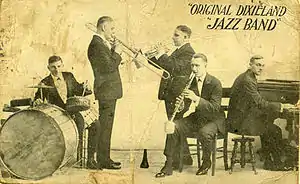 1918 promotional postcard of the ODJB showing (from left), drummer Tony Sbarbaro (aka Tony Spargo), trombonist Edwin "Daddy" Edwards, cornetist Dominick James "Nick" LaRocca, clarinetist Larry Shields, and pianist Henry Ragas | |
| Background information | |
| Origin | New Orleans, Louisiana |
| Genres | Jazz |
| Years active | 1916–1925, 1936–1938 |
| Past members | |
The band consisted of five musicians who had played in the Papa Jack Laine bands.
ODJB billed itself as the Creators of Jazz. It was the first band to record jazz commercially and to have hit recordings in the genre. Band leader and cornetist Nick LaRocca argued that ODJB deserved recognition as the first band to record jazz commercially and the first band to establish jazz as a musical idiom or genre.
Origins
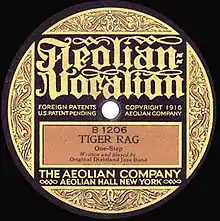
In early 1916, a promoter from Chicago approached clarinetist Alcide Nunez and drummer Johnny Stein about bringing a New Orleans-style band to Chicago, where the similar Brown's Band From Dixieland, led by trombonist Tom Brown, was enjoying success.[9] They then assembled trombonist Eddie Edwards, pianist Henry Ragas, and cornetist Frank Christian. Shortly before they were to leave, Christian backed out, and Nick LaRocca was hired as a last-minute replacement.
On March 3, 1916 the musicians began their job at Schiller's Cafe in Chicago under the name Stein's Dixie Jass Band. The band was a hit and received offers of higher pay elsewhere. Since Stein as leader was the only musician under contract by name, the rest of the band broke off, sent to New Orleans for drummer Tony Sbarbaro, and on June 5, started playing under the name, The Dixie Jass Band. LaRocca and Nunez had personality conflicts, and on October 30 Tom Brown's Band and ODJB agreed to swap clarinetists, bringing Larry Shields into the Original Dixieland Jass Band. The band attracted the attention of theatrical agent Max Hart, who booked the band in New York City. At the start of 1917 the band began an engagement playing for dancing at Reisenweber's Cafe, on Columbus Circle, in Manhattan.
First recordings
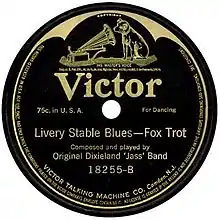
While a couple of other New Orleans bands had passed through New York City slightly earlier, they were part of vaudeville acts. ODJB, on the other hand, played for dancing and hence, were the first "jass" band to get a following of fans in New York and then record at a time when the American recording industry was essentially centered in the northeastern United States, primarily in New York City and Camden, New Jersey.
Shortly after arriving in New York, a letter dated January 29, 1917, offered the band an audition for the Columbia Graphophone Company. The session took place on Wednesday, January 31, 1917. Nothing from this test session was issued.[10]
The band then recorded two sides for the Victor Talking Machine Company, "Livery Stable Blues" and "Dixieland Jass Band One-Step", on February 26, 1917 at Victor's New York studios.[11] These titles were released as Victor 18255 in May 1917, the first issued jazz record.[12][13] The band's recordings, first marketed as a novelty, were a surprise hit, and gave many Americans their first taste of jazz. Musician Joe Jordan sued, since the "One Step" incorporated portions of his 1909 ragtime composition "That Teasin' Rag". The record labels subsequently were changed to "Introducing 'That Teasin' Rag' by Joe Jordan". A court case dispute over the authorship of "Livery Stable Blues" resulted in the judge declaring the tune in the "public domain".
In the wake of the group's success of the Victor record, the ODJB returned to Columbia in May, recording two selections of popular tunes of the day chosen for them by the label (possibly hoping to avoid the copyright problems which arose after Victor recorded two of the band's supposedly original compositions) "Darktown Strutters' Ball" and "(Back Home Again in) Indiana" as catalogue #A-2297.
Numerous jazz bands were formed in the wake of the success of ODJB that copied and replicated its style and sound. Also bands were brought from Chicago and California (such as the Frisco Jass Band) in an attempts to join the jazz craze. Established bands of different types and bandleaders such as Wilbur Sweatman began billing their groups as "jass" or "jazz" bands. Earl Fuller, bandleader at a competing New York venue, was ordered by management to form a "jass" band.
W. C. Handy recorded one of the earliest cover versions of an ODJB tune when he released a recording of "Livery Stable Blues" by Handy's Orchestra of Memphis for Columbia in 1917.
In 1918, the song "When You Hear That Dixieland Jazz Band Play" by Shelton Brooks, "the King of Ragtime Writers", was published by Will Rossiter in Chicago. It was a tribute to the Original Dixieland Jazz Band, who were featured on the cover.[14][15]
Original New Orleans Jazz Band
When the New Orleans Jazz style swept New York by storm in 1917 with the arrival of the Original Dixieland Jazz Band, Jimmy Durante was part of the audience at Reisenweber's Cafe on Columbus Circle when ODJB played that venue. Durante was very impressed with the band and invited them to play at a club called the Alamo in Harlem where Jimmy played piano.
Durante had his friend, Johnny Stein (the previous drummer and leader of the group), assemble a group of like-minded New Orleans musicians to accompany his act at the Alamo. Stein did so, with a band consisting of fellow veterans of the Laine bands in New Orleans, other than pianist Durante. In late 1918 they recorded two sides for Okeh under the name of the New Orleans Jazz Band. They recorded the same two numbers a couple of months later for Gennett under the name of Original New Orleans Jazz Band, and in 1920 the same group recorded again for Gennett as Jimmy Durante's Jazz Band. They later billed themselves as "Durante's Jazz and Novelty Band".
Sicilian influence
Both LaRocca and Sbarbaro were children of immigrants from the Italian region of Sicily.[16] The Sicilian capital of Palermo had long held cotton and citrus fruit trade with New Orleans.[16] This resulted in the establishment of a direct shipping line between the two port cities which enabled a vast number of Sicilians to migrate to New Orleans, and other American cities, between the late 1800s and early 1900s.[16] With this migration, Sicilian sound was brought to New Orleans and integrated with regional African-American music.[16][17] The band would capitalize on this growing integration.[16]
Later history of the band
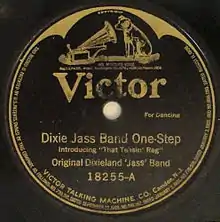
After their initial recording for the Victor Company, the ODJB recorded for Columbia Records (after the first Victor session, not before as has sometimes been reported) and Aeolian-Vocalion in 1917, then returned to Victor the following year, while enjoying continued popularity in New York. Trombonist Edwards was drafted for World War I in 1918 and replaced by Emile Christian, and pianist Henry Ragas died of influenza in the 1918 flu pandemic the following year and he was replaced by pianist and composer J. Russel Robinson.
Robinson composed the jazz standard "Eccentric" ("That Eccentric Rag"), "Margie", "Jazzola", "Singin' the Blues, which was recorded by Bix Beiderbecke, Frankie Trumbauer, and Eddie Lang, "Mary Lou", "Pan Yan (And His Chinese Jazz Band)", "How Many Times?", "Aggravatin' Papa (Don't You Try to Two-Time Me)", "What Are Little Girls Made Of?", "Get Rhythm in Your Feet", recorded by Red Allen and His Orchestra with Chu Berry, "Yeah Man!", recorded by Fletcher Henderson and His Orchestra in 1933 and released on Vocalion, "Reefer Man" for Cab Calloway in 1932, "Dynamite Rag", "Meet Me at No Special Place", recorded by Nat King Cole, "Alhambra Syncopated Waltzes", "Te-na-na (From New Orleans)", "Beale Street Mama", recorded by Bessie Smith and Cab Calloway, and "Palesteena (Lena from Palesteena)". In 1916, Robinson, whose name appeared as "J. Russel Robinson", collaborated with W. C. Handy on the song "Ole Miss Rag". In 1919, Robinson collaborated with Handy and Charles N. Hillman on "Though We're Miles and Miles Apart", which was released by Handy's publishing company. Robinson also wrote the blues classic "St. Louis Gal", which was recorded by Bessie Smith.
Robinson's compositions for the band recorded and released in 1920, include the classic "Margie" and "Palesteena (Lena from Palesteena)", were among the most popular and best-selling hits of 1920. "Aggravatin' Papa" was composed with lyricist Roy Turk and Addie Britt and was recorded by Alberta Hunter in 1923 with Fletcher Henderson's Dance Orchestra and also by Bessie Smith, Sophie Tucker, Florence Mills, Lucille Hegamin, and Pearl Bailey. Robinson also collaborated with Roy Turk on the compositions "Sweet Man O' Mine" and "A-Wearin' Away the Blues", and he wrote "Mama Whip! Mama Spank! (If Her Daddy Don't Come Home)" for blues and jazz singer Mamie Smith and her Jazz Band in 1921, which were released on the Okeh label. Robinson was a member of the band until it broke up in 1923. He rejoined the band when it reformed in 1936.
"Margie", composed by J. Russel Robinson with Con Conrad, with lyrics added by Benny Davis, has been covered over a hundred times. "Margie" has been recorded by Louis Armstrong, who also covered the band's "Tiger Rag", Ray Charles, Al Jolson, Duke Ellington and His Orchestra in 1935, the Billy Kyle Swing Club Band, Claude Hopkins, Red Nichols, Django Reinhardt, George Paxton, the Dutch Swing College Band, Fats Domino, Sidney Bechet, Don Redman, Cab Calloway, Jim Reeves, Gene Krupa, and Benny Goodman.
"Margie" was a no. 9 hit for ODJB in 1921 with J. Russel Robinson on piano. Eddie Cantor had the biggest hit version of the ODJB classic, spending five weeks at no. 1 in 1921. The song also was featured in the movie The Eddie Cantor Story and was the theme of the television series of the same name in 1961–1962. Cantor also recorded ODJB's "Palesteena (Lena from Palesteena)". Gene Rodemich and His Orchestra reached no. 7 with their version in 1920. Ted Lewis and His Band reached no. 4 in 1921. Frank Crumit had a no. 7 hit in 1921. Claude Hopkins and His Orchestra reached no. 5 in 1934 with Orlando Peterson on vocals. Don Redman and His Orchestra got to no. 15 in 1939 with a cover of the ODJB song. Dave Brubeck, Bix Beiderbecke, Bing Crosby, Jo Stafford, Erroll Garner, Oscar Peterson, Charlie Shavers, Jimmy Smith, Joe Venuti, Ray Barretto, and Shelly Manne also have recorded the song. Jimmie Lunceford recorded the song in 1938 with a Sy Oliver arrangement that featured Trummy Young.
London tour
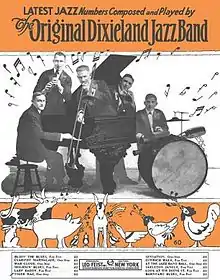
Other New Orleans musicians, including Nunez, Tom Brown, and Frank Christian, followed ODJB's example and went to New York to play jazz as well, giving the band competition. LaRocca decided to take the band to London, where they would once again enjoy being the only authentic New Orleans jazz band in the metropolis, and again present themselves as the Originators of Jazz because they were the first band to record the new genre of music dubbed jass or jazz. The band's April 7, 1919 [18] appearance in the revue Joy Bells at the London Hippodrome was the first official live jazz performance by any band in the United Kingdom[19] and was followed by a command performance for King George V at Buckingham Palace. The concert did not start auspiciously, with the assembled aristocracy, which included French Marshal Philippe Pétain, peering through opera glasses at the band "as though there were bugs on us", according to LaRocca. The audience loosened up, however, after the king laughed and loudly applauded their rendition of "The Tiger Rag". The British tour ended with the band being chased to the Southampton docks by Lord Harrington, who was infuriated that his daughter was being romanced by the lead singer of the band.[20][21] In London, they made twenty more recordings for the British branch of Columbia. While in London, they recorded the second, more commercially successful, version of their hit song "Soudan" (also known as "Oriental Jass").
The band returned to the United States in July 1920 and toured for four years. This version of the band played in a more commercial style, adding a saxophone to the arrangements in the manner of other popular orchestras. In 1927 LaRocca was replaced by 19-year-old trumpeter Henry Levine, who later brought this kind of repertoire to the NBC radio show The Chamber Music Society of Lower Basin Street. Jazz pianist and composer Frank Signorelli, who collaborated on the jazz standards "A Blues Serenade", recorded by Glenn Miller and Duke Ellington, "Gypsy", and "Stairway to the Stars", joined ODJB for a brief time in 1921.
Break-up
The band broke up in the late 1920s and its originators scattered. During the Depression, trombonist Eddie Edwards was discovered operating a newsstand in New York City. Newspaper publicity resulted in Edwards fronting a local nightclub band.
In 1936, the musicians played a reunion performance on network radio. Victor invited them back into the recording studio, and over the next two years the band recorded 25 sides for Victor as "The Original Dixieland Five." The group toured briefly before disbanding again. Clarinetist Larry Shields received particularly positive attention on this tour, and Benny Goodman has commented that Shields was an important early influence.
In the 1940s and 1950s, Edwards and Sbarbaro both formed bands without other original members under the ODJB name; Teddy Roy was one of the players in Edwards's version of the band. In 1944, a new version of "Tiger Rag" was released as V-Disc 214 by the reformed band. "Sensation Rag" also was released as V-Disc 214B2. V-Discs were non-commercial recordings issued only to the U.S. armed forces.
Back in New Orleans, LaRocca licensed bandleader Phil Zito to use the ODJB name for many years. Nick LaRocca's son, Jimmy LaRocca, continues to lead bands under the name The Original Dixieland Jazz Band.
In 1960 the book, The Story of the Original Dixieland Jazz Band, was published. Writer H. O. Brunn based it on Nick LaRocca's recollections, which sometimes differ from that of other sources.
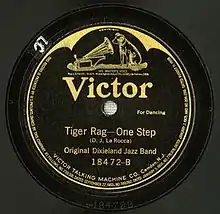
Influence
ODJB was the first band to record jazz successfully, establishing and creating jazz as a new musical idiom and genre of music. Bix Beiderbecke was influenced by the ODJB to become a jazz musician and was heavily influenced by Nick LaRocca's cornet and trumpet style. Louis Armstrong acknowledged the importance of ODJB:
Only four years before I learned to play the trumpet in the Waif's Home, or in 1909, the first great jazz orchestra was formed in New Orleans by a cornet player named Dominick James LaRocca. They called him 'Nick' LaRocca. His orchestra had only five pieces but they were the hottest five pieces that had ever been known before. LaRocca named this band 'The Old Dixieland Jass Band'. He had an instrumentation different from anything before, an instrumentation that made the old songs sound new. Besides himself at the cornet, LaRocca had Larry Shields, clarinet, Eddie Edwards, trombone, Ragas, piano, and Sbarbaro, drums. They all came to be famous players and the Dixieland Band has gone down now in musical history.
— Louis Armstrong, Swing That Music, 1936[22]
Film appearances
In 1917, the band made the first appearance of a jazz band in a motion picture, a silent movie entitled, The Good for Nothing (1917), directed by Carlyle Blackwell, who also played the lead role as Jack Burkshaw. Written by Alexander Thomas, it also featured Evelyn Greeley and Kate Lester and was produced by William Brady. Nick LaRocca, Larry Shields, Tony Sbarbaro, and Henry Ragas appeared in the film as a band, with LaRocca on cornet, Shields on clarinet, Ragas on piano, and Sbarbaro on drums. The film was released on December 10, 1917, produced by Peerless Productions, and distributed by World Pictures.
Nick LaRocca and the reunited Original Dixieland Jass Band performed "Tiger Rag" in The March of Time newsreel segment titled "Birth of Swing," released to U.S. theaters February 19, 1937.[23]
Music of ODJB
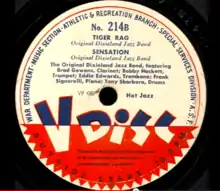
"Tiger Rag"
The band's 1917 composition "Tiger Rag" became one of the most popular and ubiquitous of jazz standards. There were 136 cover versions of ODJB's copyright jazz standard and classic "Tiger Rag" by 1942. It has been standard ever since.
Their first release, "Livery Stable Blues", featured instruments doing barnyard imitations and the fully loaded trap set, wood blocks, cowbells, gongs, and Chinese gourds. This musical innovation represented one of the first experimental exercises in jazz. At the time, their music was liberating; the barnyard sounds were experiments in altering the tonal qualities of the instruments, and clattering wood blocks broke up the rhythm. The music was very lively when compared to the pop music of the time.
Many of the tunes first composed and recorded by the Original Dixieland Jass Band, such as "Tiger Rag" and "Margie", were recorded by many of the major jazz bands and orchestras of the twentieth century, black and white. "Tiger Rag" was recorded by many artists, from Louis Armstrong to Duke Ellington to Glenn Miller to Benny Goodman. "Tiger Rag", in particular, became popular with many colleges and universities having a tiger as a mascot. In the biography John Coltrane: His Life and Music, published in 1999, Lewis Porter noted that ODJB's classic, "Margie", was a "specialty" of John Coltrane, a song he performed regularly in his early career. "Tiger Rag", "Margie", "Clarinet Marmalade", "At The Jazz Band Ball", "Sensation Rag", and "Fidgety Feet" remain much played classics in the repertory of contemporary Dixieland and traditional jazz bands. Their tunes were published as collaborations by some or all of the entire ensemble, including band leader Nick La Rocca.
The Original Dixieland Jazz Band recording of "Tiger Rag" was no. 1 for two weeks on the U.S. Hit Parade charts beginning on December 11, 1918. The Mills Brothers recorded "Tiger Rag" in 1931 with lyrics and spent four weeks at no. 1 on the charts in 1931–1932 with their version of the ODJB song.
The Eddie Edwards composition "Sensation Rag" (aka "Sensation") was performed at the 1938 landmark Benny Goodman jazz concert at Carnegie Hall released on the album The Famous 1938 Carnegie Hall Jazz Concert.
Compared to later jazz, the ODJB recordings have only modest improvisation in mostly ensemble tunes. Clarinetist Larry Shields is perhaps the most interesting player, showing a good fluid tone, and if his melodic variations and breaks now seem overly familiar, this is because they were imitated widely by musicians who followed in the band's footsteps.
Their concept of arrangement was somewhat limited, and their recordings can seem rather repetitive. The lack of a bass player is scarcely compensated for by the piano on their earlier, acoustically recorded sessions. Nonetheless, ODJB arrangements were wild, impolite, and definitely had a jazz feel, and that style still is referred to as the style of music known as Dixieland.
Covers
ODJB's songs were recorded by other musicians, such as Fletcher Henderson and His Orchestra, one of the most popular and influential jazz bands of the 1920s.
- "Beale Street Mama" – by J. Russel Robinson, recorded by Henderson in 1923 as an instrumental on Paramount.
- "Clarinet Marmalade" – recorded in 1926, released on Vocalion and Brunswick. In 1931, Henderson recorded a new version for Columbia.
- "Livery Stable Blues" – recorded in 1927, released on Columbia
- "Fidgety Feet" – by Nick LaRocca, recorded in 1927, released on Vocalion
- "Sensation" – recorded in 1927, released on Vocalion
- "Tiger Rag" – recorded in 1931, released on Crown
- "Aggravatin' Papa" – collaboration with Robinson, recorded in 1923 with Alberta Hunter on vocals
- "Singin' the Blues (Till My Daddy Comes Home)" – recorded in 1931 with Rex Stewart on cornet
Bix Beiderbecke recorded nine compositions associated with the ODJB from 1924 to 1930: "Fidgety Feet", his first recording in 1924, "Tiger Rag", "Sensation", "Lazy Daddy", "Ostrich Walk", "Clarinet Marmalade", "Singin' the Blues" with Frankie Trumbauer and Eddie Lang, "Margie", and "At the Jazz Band Ball".
Recordings
The band's seminal 78-rpm recordings include the following (on Victor, Columbia, and Aeolian Vocalion):
1917–1920
- "Dixie Jass Band One-Step"/"Introducing That Teasin' Rag"/"Livery Stable Blues", 1917, Victor 18255. This was the second pressing. The original title of the A side was "Dixieland Jass Band One-Step".
- "At the Jazz Band Ball"/"Barnyard Blues", 1917, Aeolian Vocalion A1205
- "Ostrich Walk"/"Tiger Rag", 1917, Aeolian Vocalion A1206
- "Reisenweber Rag/Look at 'Em Doing It Now", 1917, Aeolian Vocalion 1242
- "Darktown Strutters' Ball"/"(Back Home Again in) Indiana", 1917, Columbia A2297; the ODJB recording of "Darktown Strutters' Ball" was inducted into the Grammy Hall of Fame on February 8, 2006
- "At the Jazz Band Ball" (1918 version)/"Ostrich Walk" (1918 version), 1918, Victor 18457
- "Skeleton Jangle"/"Tiger Rag" (1918 version), 1918, Victor 18472
- "Bluin' the Blues"/"Sensation Rag", 1918, Victor 18483
- "Mournin' Blues"/"Clarinet Marmalade", 1918, Victor 18513, "Mournin' Blues" also appeared as "Mornin' Blues" on some releases. The full B side title was "Clarinet Marmalade Blues".
- "Fidgety Feet (War Cloud)"/"Lazy Daddy", 1918, Victor 18564
- "Lasses Candy"/"Satanic Blues", 1919, Columbia 759
- "Oriental Jazz" (or "Jass"), 1919, recorded November 24, 1917 and issued as Aeolian Vocalion 12097 in April 1919 with "Indigo Blues" by Ford Dabney's Band
- "At the Jazz Band Ball" (1919 version)/"Barnyard Blues" (1919 version), 1919, recorded in London, England, April 16, 1919, English Columbia 735
- "Soudan" (also known as "Oriental Jass" and "Oriental Jazz"), 1920, recorded in London, England, in May 1920 and released as English Columbia 829; was composed by Czech composer Gabriel Sebek in 1906 as "In the Soudan: A Dervish Chorus" or "Oriental Scene for Piano, Op. 45". The B side was "Me-Ow" by the London Dance Orchestra
- "Margie"/"Singin' the Blues"/"Palesteena", 1920, Victor 18717
- "Broadway Rose"/"Sweet Mama (Papa's Getting Mad)"/"Strut, Miss Lizzie", 1920, Victor 18722
1921–1946
- "Home Again Blues"/"Crazy Blues"/"It's Right Here For You (If You Don't Get It, Tain't No Fault O' Mine)", 1921, Victor 18729
- "Tell Me/Mammy o' Mine", 1921, recorded in the UK and released as Columbia 804
- "I'm Forever Blowing Bubbles"/"My Baby's Arms", 1921, Columbia 805
- "I've Lost My Heart in Dixieland"/"I've Got My Captain Working for Me Now", 1921, Columbia 815
- "Sphinx/Alice Blue Gown", 1921, Columbia 824
- "Jazz Me Blues/St. Louis Blues", 1921, Victor 18772
- "Royal Garden Blues"/"Dangerous Blues", 1921, Victor 18798
- "Bow Wow Blues (My Mama Treats Me Like a Dog)", 1922, Victor 18850. The B side was "Railroad Blues" by the Benson Orchestra of Chicago under pianist and composer Roy Bargy
- "Toddlin' Blues"/"Some of These Days", 1923, Okeh 4738
- "You Stayed Away Too Long/Slipping Through My Fingers", 1935, Vocalion 3099
- "Original Dixieland One-Step/Barnyard Blues" (new version of "Livery Stable Blues"), 1936, Victor 25502
- "Who Loves You?"/"Did You Mean It?", 1936, Victor 25420, featuring vocals by Chris Fletcher and trumpet by Nick LaRocca
- "Old Joe Blade", 1936, Victor 26039-B, Nick LaRocca and the Original Dixieland Band featuring J. Russel Robinson on vocals
- "Good-Night, Sweet Dreams, Good-Night"/"In My Little Red Book", 1938, Bluebird B-7444, which featured vocals by Lola Bard
- "Tiger Rag" (1943 version), 1944, V-Disc 214B1, issued June, 1944, with Eddie Edwards and Tony Sbarbaro
- "Sensation" (1943 version), 1944, V-Disc 214B2, with Eddie Edwards and Tony Sbarbaro
- "Shake It and Break It"/"When You and I Were Young, Maggie", 1946, Commodore C-613
Soundtracks
The soundtrack album to the 2011 Boardwalk Empire series on HBO includes performances of three songs recorded by the Original Dixieland Jazz Band: "Livery Stable Blues", "Mournin' the Blues", and "Margie", performed by Vince Giordano and the Nighthawks Orchestra.[24] The soundtrack won the Grammy Award for Best Compilation Soundtrack for Visual Media at the 54th Grammy Awards. [25]
Honors
In 1977, the ODJB classic "Singin' the Blues", co-written by ODJB pianist J. Russel Robinson, was inducted into the Grammy Hall of Fame in a landmark 1927 recording by Frankie Trumbauer and His Orchestra featuring Bix Beiderbecke on cornet and Eddie Lang on guitar, as Okeh 40772-B, recorded on February 4, 1927.
On April 3, 1992, the City Council of New Orleans issued a proclamation honoring the members of the band. In 2003, the 1918 ODJB recording of "Tiger Rag" was placed on the U.S. Library of Congress National Recording Registry. In 2006, the Original Dixieland Jazz Band's recording of "Darktown Strutters' Ball", released in 1917 as Columbia single A2297, was inducted into the Grammy Hall of Fame.
The Original Dixieland Jazz Band was posthumously inducted into the Grammy Hall of Fame, which is a special Grammy award established in 1973 to honor recordings that are at least 25 years old and that have "qualitative or historical significance."
| Original Dixieland Jazz Band: Grammy Hall of Fame Awards[26] | |||||
| Year Recorded | Title | Genre | Label | Year Inducted | Notes |
|---|---|---|---|---|---|
| 1917 | "Darktown Strutters' Ball" | Jazz (single) | Columbia | 2006 | |
See also
 Jazz portal
Jazz portal Music portal
Music portal
Notes
- Russell, Tony (1997). The Blues: From Robert Johnson to Robert Cray. Dubai: Carlton Books Limited. p. 12. ISBN 1-85868-255-X.
- Schoenherr, Steven. "Recording Technology History". History.sandiego.edu. Archived from the original on March 12, 2010. Retrieved 2008-12-24.
- Thomas, Bob (1994). "The Origins of Big Band Music". redhotjazz.com. Archived from the original on 2008-12-28. Retrieved 2008-12-24.
- Alexander, Scott. "The First Jazz Records". redhotjazz.com. Archived from the original on 2008-12-28. Retrieved 2008-12-24.
- "Jazz Milestones". apassion4jazz.net. Retrieved 2008-12-24.
- "Original Dixieland Jazz Band Biography". pbs.org. Retrieved 2008-12-24.
- Martin, Henry; Waters, Keith (2005). Jazz: The First 100 Years. Thomson Wadsworth. p. 55. ISBN 0-534-62804-4.
- "Tim Gracyk's Phonographs, Singers, and Old Records – Jass in 1916-1917 and Tin Pan Alley". Gracyk.com. Retrieved 2007-10-27.
- "Tom Brown". The Red Hot Archive. Archived from the original on 2013-06-25. Retrieved 2007-10-27.
- Charters, Samuel. 2008. A Trumpet Around the Corner: The Story of New Orleans Jazz. Univ. Press of Mississippi. p. 141. ISBN 1604733187.
- John Robert Brown, A Concise History of Jazz. Mel Bay Publications, 2004, p. 25. ISBN 0-7866-4983-6
- "The First Jazz Records". Redhotjazz.com. Archived from the original on 2008-12-28. Retrieved 2008-12-24.
- "Victor 18255 (Black label (popular) 10-in. double-faced) - Discography of American Historical Recordings". Adp.library.ucsb.edu.
- Graczyk, Tim, with Frank Hoffmann. Popular American Recording Pioneers: 1895-1925. London and New York: Routledge, 2008, p. 257.
- ""When You Hear that Dixieland Jazz Band Play" - Hogan Jazz Archive". Specialcollections.tulane.edu.
- Viale, Valerio (10 March 2017). "First Recording in Jazz History has strong Sicilian roots". Italoamericano.org. Archived from the original on 14 August 2018. Retrieved 14 August 2018.
- "The Sicily-New Orleans Connection: Jazz is the Art of Encounter par Excellence". Lavocedinewyork.com.
- Glinert, Ed (June 5, 2008). "West End Chronicles: 300 Years of Glamour and Excess in the Heart of London". Penguin Books Limited – via Google Books.
- Edwards, Tom (May 1950). "Jazz Band Ball: New Orleans to Hammersmith". Jazz Illustrated 1 (6): 11.
- ""Buckingham Palace hits right note with jazz fans", London Evening Standard (August 3, 2009)".
- Bates, Stephen (August 3, 2009). "By royal approval: Buckingham Palace's place in jazz history". Theguardian.com.
- Armstrong, Louis (1993). Swing That Music. Da Capo Press. pp. 9–10. ISBN 0-306-80544-8.
- Synopsis Archived 2015-02-06 at the Wayback Machine (PDF), The March of Time Newsreels, HBO Archives
- "'Boardwalk Empire' soundtrack full listing, including Regina Spektor's take on 'My Man': Hear it here -- EXCLUSIVE". 10 August 2011.
- Eddie Gribben (13 Feb. 2012), "Boardwalk Empire Even Wins at the Grammys"; available at https://www.buckscountycouriertimes.com/article/20120213/BLOGS/302139834?template=ampart
- "Grammy Hall of Fame Database". Archived from the original on July 7, 2015.
References
| Wikimedia Commons has media related to Original Dixieland Jass Band. |
- The ODJB on RedHotJazz Contains .ram files of their vintage recordings.
- Jimmy LaRocca's Original Dixieland Jazz Band
- Stewart, Jack. "The Original Dixieland Jazz Band's Place in History". The Jazz Archivist, Vol. VI, No. 1 (May, 1991), p. 7-8.
- Stewart, Jack. "The Original Dixieland Jazz Band's Place in the Development of Jazz". New Orleans International Music Colloquium, 2005.
- Lange, Horst H. Wie der Jazz begann: 1916-1923, von der "Original Dixieland Jazz Band" bis zu King Olivers "Creole Jazz Band". Berlin: Colloquium Verlag, 1991. ISBN 3-7678-0779-3
- Brunn, H.O. The Story of the Original Dixieland Jazz Band. Baton Rouge: Louisiana State University Press, 1960. Reprinted by Da Capo Press, 1977. ISBN 0-306-70892-2
- Original Dixieland Jazz Band Discography.